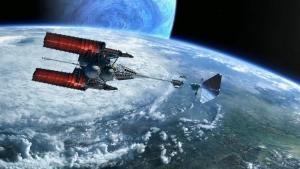Post
Faster Than Light
28 October 2012
 20th Century Fox
20th Century FoxThere’s been a couple of questions about the possibility of traveling faster than light, so let’s explore that a bit today. The short answer to whether one can travel faster than light is no. The inertial speed of an object can never exceed the speed of light. This means if you measure the speed of an object passing you, it will always be less than the speed of light. The longer answer is “it’s complicated.”
The reason it’s complicated is because we like to think of speed as the motion of an object in some absolute, universal reference frame. In our every day experience this works just fine. In general, however, it doesn’t work. For one thing, motion is relative, so an object’s “speed” depends who’s measuring it. At speeds approaching light, special relativity also comes into play, which leads to strange things like time dilation and length contraction.
To demonstrate this, suppose we had a rocket that could accelerate at a constant 1 gee. This would mean the passengers of our rocket would experience the same “weight” they feel on Earth. To travel to another star, we simply accelerate toward our destination until we are halfway there, coast just long enough to flip the ship around, then decelerate for the second half of our journey so that we stop at the end of our journey.
The nearest star system is Alpha Centauri, which is 4.3 light years away. The trip on our 1-gee rocket would take about 5.8 years from Earth’s point of view, and our ship would reach a maximum speed of 0.948 c, or just shy of 95% of light speed. From the point of view of the passengers, the trip would take only 3.56 years. From the point of view of our passengers, they traveled 4.3 light years in 3.56 years, which is an average speed 1.2 times faster than light!
 Brian Koberlein
Brian KoberleinThings get more strange if we take a trip to Gliese 876, a star system 15.3 light years away with 4 known planets. Seen from Earth, the rocket will take 16.7 years to reach Gliese, and reach a maximum speed of 0.993 c. For our passengers, however, the trip will only take 5.6 years, so their perceived average speed is 2.7 c. I’ve plotted the travel time of our passengers as a function of the distance of their trip in the figure. You can see that the farther they go, the more dramatic this effect gets. Taken to extremes, our passengers could travel to the Andromeda galaxy (2 million light years away) in only 28 years from their point of view.
So what’s really going on here? One thing all observers can agree upon is that the speed of light (in a vacuum) is constant from their point of view. A lab on Earth, and a lab on our accelerating spaceship will both measure the same speed. The only way for an Earth lab and a lab moving at nearly the speed of light to agree on light speed is for time and distance to depend on your point of view. In other words, space and time are relative.
As the rocket speeds up, observers on Earth would see that time for the passengers is slowing down. So Earth observers would say the trip to Gliese actually took 16.7 years, but the slowing of the passenger’s time means only 5.6 years passed for them. From the view of the passengers, the distance between the Earth and Alpha Centauri appears to get shorter as they speed up. At any point in their trip they would still measure their speed to be less than light, its just that the faster Earth and Gliese are moving relative to them, the shorter their separation distance appears to be.
Clearly our rocket is not real, so you might be inclined to think that this is all speculation, but these effects have been observed on a smaller scale. In fact, the GPS in your phone has to correct for these effects in order to work properly.
The upshot of all this is that “speed,” “distance” and “time” depend on your point of view, and they change in such a way that all observers measure the same speed of light.
Of course if you add gravity to the mix, things get even more interesting. But I’ll save that for another time.